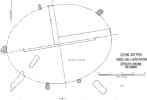|
SURVEY OF A STONE SETTING AT CNOC AN LIATH-BHAID STRATH BRORA L. J . Myatt At a height of 275m, and 0.9km ENE of the croft of Braegrudie, in Strath Brora, at NC 728102, is a setting of standing stones of which five still remain standing and a further three lie fallen on the ground. Within the setting are the remains of a cairn, and in the vicinity are numerous, low, peat covered mounds. The stones are set with their broad faces pointing inwards, with the tallest stone to the west. From an analysis of a large number of settings of standing stones Thom (1967 p.34) claims that a standard unit of length was used for laying them out. Many are circular in plan, whilst others are flattened circles, egg shaped or elliptical. The standard unit of length he terms the Megalithic Yard (MY) and further demonstrates its value to be 0.829m (2.72ft.). It would appear that, in setting out the stone circles, megalithic man had a concern for whole numbers of length, and in general with the circle it is not possible to have this for both the diameter and circumference. This may be why he decided to use the ellipse. Whereas a circle can easily be marked out on the ground by using rope of hide or heather attached to a centre post and pulling it taut around the post, an ellipse can be similarly formed using two posts. In this case a loop of rope is passed around two posts set a distance apart so that it can be pulled to form a triangle. By keeping the rope taut and moving it around the posts an ellipse can be marked out. The positions of the two posts are at the so-called foci of the ellipse which has two main diameters a major one and a minor one. The stone setting at Cnoc an Liath-Bhaid was surveyed by the writer, and since five points can be used to define an ellipse an attempt was made to fit such a curve to the setting. The ellipse chosen as shown on the plan is such that the distance between the foci (i.e. posts) is 7.5MY and the major and minor diameters are 11MY and 8.05MY respectively. The difference between the last dimension and an integral 8MY would be so small as to be unnoticeable. The perimeter of the ellipse thus formed would have a length of 30.1MY and if this were determined by means of a series of successive measurements using a straight measuring stick 1MY long the difference between its actual length and 30MY would again be imperceptible. Thus to all intents and purposes we have a stone setting at Cnoc an Liath-Bhaid where the major and minor diameters and also the perimeter are all of integral lengths From details given by Thom (1967 P.72) of his survey of the stone setting at Croftmoraig, Perthshire (NN 797473) this also fits the same ellipse as Cnoc an Liath-Bhaid. R E F E R E N C E
|
